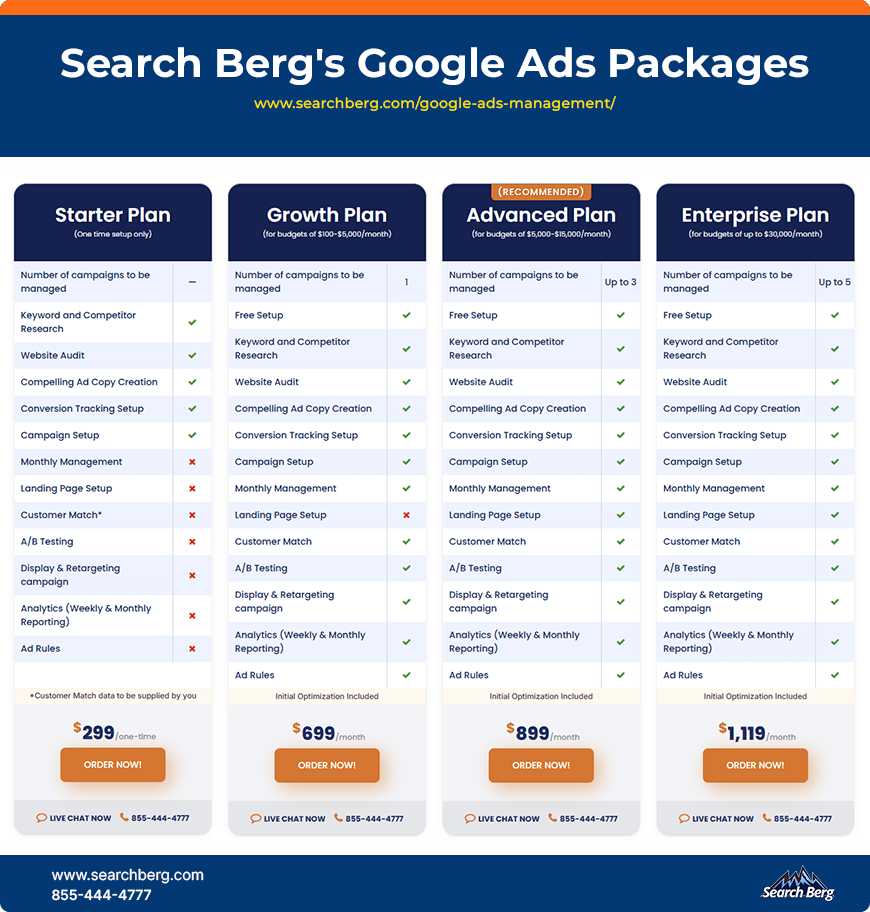How Much Do Google Ads Cost? ROI Tips for 2024
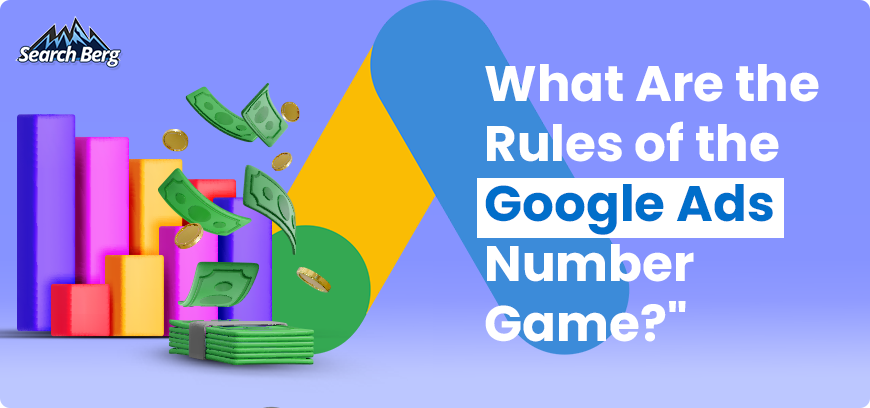
Google Ads is a powerhouse. But like any powerful tool, it requires careful handling and a deep understanding of its inner workings.
One of the most critical aspects of mastering Google Ads is knowing exactly how much it costs.
Why is this so important? Because without a clear grasp of Google Ads pricing, you risk two major pitfalls:
- Overspending: You pour money into campaigns without a clear strategy, potentially wasting your budget on ineffective ads or irrelevant keywords.
- Under spending: You’re too cautious with your budget, limiting your reach and missing out on valuable conversions. This results in disappointing results and a missed opportunity to grow your business.
Neither scenario is ideal, especially when you’re first dipping your toes in the Google Ads management waters and can’t afford to make critical mistakes.
That’s why we’re diving deep into the intricacies of Google Ads cost in this comprehensive guide.
We’ll demystify the pricing models, break down the factors that influence your spending, and equip you with the knowledge to optimize your campaigns for maximum efficiency. We’ll also weave in expert ROI tips to help you generate real value from your Google Ads campaigns.
Are you with us?
1. Decoding Google Ads Pricing: How Much Does It Really Cost?

The million-dollar question (or perhaps, the thousand-dollar question, depending on your budget) is “How much does it cost to advertise on Google?”
The truth is there’s no one-size-fits-all answer. Google Ads operates on a pay-per-click (PPC) model, i.e., you only pay when someone clicks on your ad. However, the cost of each click can vary significantly based on several factors.
It’s kind of like an auction. You’re competing with other advertisers for the same ad space, and the price you pay depends on how much you’re willing to bid and how relevant Google deems your ad to be. It’s a dynamic system where multiple elements come into play.
Here’s a breakdown of the key elements that influence Google Ads costs:
- Industry: Highly competitive industries (e.g., finance, insurance, legal) tend to have higher costs-per-click due to increased competition for ad space. Think of it this way: if everyone wants to be at the top of the search results page for “car insurance,” the bidding war will drive up the price.
- Keywords: The keywords you target play a major role in your costs. Highly competitive, high-volume keywords will generally be more expensive. For example, a broad keyword like “shoes” will likely cost more than a more specific keyword like “women’s running shoes size 8.”
- Quality Score: Google assigns a Quality Score to your ads based on their relevance, landing page experience, and expected click-through rate. A higher Quality Score can lower your costs and improve your ad ranking. Essentially, Google rewards advertisers who create high-quality, relevant ads that provide a positive user experience.
- Bidding Strategy: Your bidding strategy (e.g., manual bidding, automated bidding) and bid amounts directly impact your costs. If you’re willing to bid higher than your competitors, you’re more likely to secure a top ad position, but it will also result in a higher cost per click on Google Ads.
- Ad Rank: Your Ad Rank determines your ad’s position on the search results page. It’s calculated based on your bid amount and Quality Score. A higher Ad Rank usually means a higher cost-per-click. This means that even if you have a lower bid than a competitor, you can still outrank them if your ad has a higher Quality Score.
- Targeting: The more specific your targeting (e.g., location, demographics, time of day), the more you may pay per click. While targeting a broad audience might seem cheaper, it can be less effective. By targeting your ads to specific demographics, locations, and even times of day, you can reach a more qualified audience and potentially increase your ROI.
- Ad Network: The Google Ads network you choose (Search Network, Display Network) can also affect your Google Ads costs. Generally, clicks on the Search Network are more expensive than those on the Display Network. This is because Search Network ads appear directly on the search results page, while Display Network ads appear on websites across the internet.
By taking these nuances into account, you can gain a deeper understanding of the cost for Google Ads and make more informed decisions about your bidding strategies and targeting options. This granular level of control can help you optimize your campaigns for maximum efficiency and ROI.
Recommended Read: Google Ads Manager Accounts (MCC) 2024 Guide
2. Google Ads Pricing Models: CPC, CPM, and More
While cost-per-click (CPC) is the most common pricing model, Google Ads offers several other options:
- Cost-Per-Thousand Impressions (CPM): You pay for every 1,000 times your ad is shown, regardless of whether it’s clicked. This is common for brand awareness campaigns on the Display Network.
- Cost-Per-View (CPV): Used for video ads, you pay when someone watches a certain portion of your video (e.g., 30 seconds).
- Cost-Per-Conversion (CPA): You pay only when your ad leads to a specific conversion, such as a purchase or sign-up. This requires conversion tracking to be set up.
Understanding these different pricing models can help you choose the best option for your campaign goals and budget.
It’s helpful to have a general idea of average Google Ads costs to benchmark your own campaigns. However, keep in mind that these are just averages, and your actual costs may vary significantly.
Here are some recent benchmarks:
- Average CPC (Search Network): $2.80
- Average CPC (Display Network): $0.75
- Average CPM (Display Network): $2.80
Important Note: These averages can fluctuate based on industry, competition, and other factors. For example, highly competitive industries like legal and finance may see CPCs well above $10, while less competitive industries may have CPCs below $1.
To get a more accurate estimate of your potential Google Ads cost, use Google’s Keyword Planner tool. This tool allows you to enter your target keywords and see estimated bid ranges and competition levels.
3. Should I Opt for a Google Ads Package?
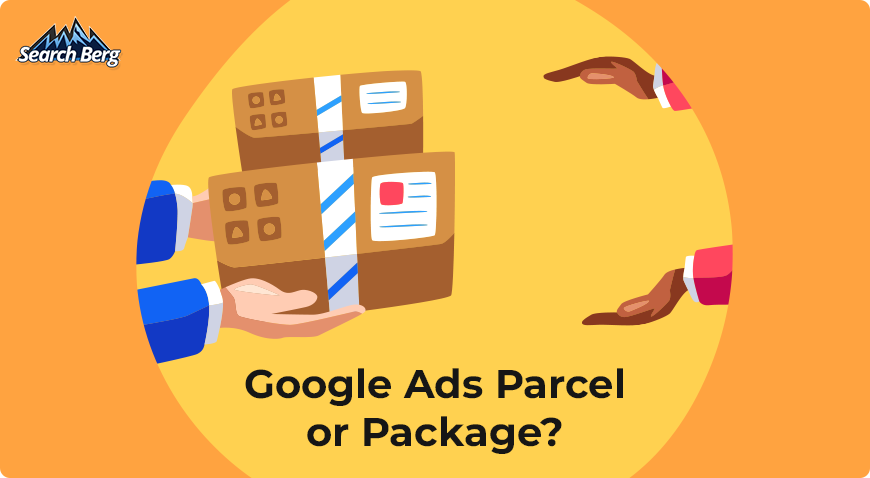
Many businesses, especially those that lack the in-house expertise and experience to manage their own campaigns effectively, prefer handing over the reins to the experts. This is where Google Ads management services enter the picture.
Google Ads service providers offer comprehensive packages that not only include Google Ads optimization and management but also extend to other valuable services. This comprehensive approach can be a true game-changer for businesses looking to maximize their return on ad spend and streamline their marketing efforts.
So, what makes Google Ads packages so appealing?
For starters, you gain immediate access to a team of experienced digital marketers who live and breathe PPC advertising. They possess the in-depth knowledge and honed skills to create, manage, and optimize your campaigns, ensuring they perform at their peak potential.
This can be a huge relief for business owners and marketing managers who are already stretched thin. Instead of getting bogged down in the technicalities of keyword research, bid management, and ad copywriting, you can free up your time to focus on other core business activities.
Google Ads packages often encompass a broader range of services. This integrated approach allows you to cast a wider net, reaching potential customers across multiple platforms and amplifying your overall results.
And while it might seem counterintuitive, bundling these services together can actually be more cost-effective than managing each one separately. You’ll often find that agencies offer package deals that provide greater value compared to à la carte services.
Of course, you’re probably wondering, “Okay, but how much do these Google Ads packages actually cost?” That’s a fair question, and the answer, as with most things in the world of digital marketing, is it depends.
Several factors influence the pricing of Google Ads packages, including:
- Scope of Services: The more services included in the package, the higher the cost.
- Management Level: Some Google Ads management agencies offer different management levels with varying degrees of service and support.
- Ad Spend: Agencies may charge a percentage of your ad spend or a flat fee based on your budget.
- Agency Experience and Reputation: Established agencies with a proven track record may command higher fees.
To give you a better idea, let’s take a look at the Google Ads packages offered by Search Berg. We believe in providing transparent and affordable solutions for businesses of all sizes, so we’ve designed our packages to cater to a variety of needs and budgets.
Choosing the right Google Ads package can feel overwhelming, but it doesn’t have to be. At Search Berg, we’re here to guide you every step of the way. Our will take the time to understand your business goals, current marketing efforts, and budget constraints. We’ll then recommend the package that best aligns with your needs and sets you up for success.
Whether you’re a small business just starting out with Google Ads or a large enterprise seeking advanced campaign management and optimization, we have a solution that’s tailored to you.
Remember, in-house Google Ads management isn’t the wrong approach if you have the right team. However, more often than not, businesses lack the expertise, experience, and wide skillset required to dominate the digital space. It’s also worth noting that Google Ads packages offered by the crème de la crème of agencies can help you save a good sum in the long run.
Put your researcher hat on and determine which option is right for you. Ultimately, your Google Ads campaign should help you get seen by your target audience, earn more clicks and conversions, and grow your business. At Search Berg, we’re confident we can get you there.
4. How to Maximize Your Google Ads ROI

While partnering with a Google Ads management agency can be a smart move, it’s also important to understand the fundamental strategies for maximizing your return on investment (ROI).
Whether you choose to manage your campaigns in-house or collaborate with an agency, having a grasp of these core principles will empower you to make informed decisions and ensure your Google Ads budget is working as hard as it should be.
4.1. Track Your Conversions
The absolute foundation of any successful Google Ads campaign is accurate conversion tracking. Without it, you’re essentially shooting in the dark.
Conversion tracking allows you to measure which keywords, ads, and campaigns are driving valuable actions on your website. These actions could be anything from purchases and sign-ups to form submissions and downloads (whatever you define as a valuable conversion for your business).
To set up conversion tracking, you’ll need to add a small snippet of code to your website (Google provides easy-to-follow instructions). Once it’s in place, you’ll be able to see exactly how many conversions each of your campaigns, ad groups, and even individual keywords are generating.
This data is pure gold.
It tells you what’s working and what’s not, allowing you to make data-driven decisions to optimize your campaigns for maximum effectiveness.
For example, if you notice that a particular keyword is generating a lot of clicks but no conversions, you may consider adjusting your bidding strategy or refining your ad copy to better qualify your traffic. Or, if you see that a certain ad is driving a high conversion rate, you can allocate more of your budget to that ad to maximize its impact.
4.2. Optimize Your Bidding Strategy
Your bidding strategy is the heart of your Google Ads management campaigns. It dictates how much you’re willing to pay per click and ultimately determines how often your ads appear and how much you spend.
Don’t fall into the trap of setting your bids once and then forgetting about them! The Google Ads jungle is dynamic, and your bidding strategy needs to adapt to stay competitive and maximize your ROI.
Regularly review and adjust your bidding strategy to ensure you’re getting the most out of your budget and achieving your desired results. This may involve increasing your bids on high-performing keywords, decreasing bids on low-performing keywords, or even switching to a different bidding strategy altogether.
To choose the best strategy, consider:
- Your Campaign Goals: What are you trying to achieve (traffic, leads, sales)?
- Your Budget: How much are you willing to spend?
- Your Expertise: How comfortable are you with managing bids manually?
- Your Time: How much time do you have to dedicate to bid management?
By experimenting with different bidding options, you can find the strategy that best suits your needs and helps you achieve your desired results.
4.3. Improve Your Quality Score
Let’s say two businesses are bidding on the same keyword in Google Ads. Business A has a Quality Score of 3, while Business B has a Quality Score of 8. Who do you think will pay less per click and have a better chance of securing a top ad position?
You guessed it… Business B!
Your Quality Score is like a seal of approval from Google. It’s a metric that reflects the overall quality and relevance of your ads and landing pages. A higher Quality Score can significantly lower your Google Ads cost and improve your ad ranking, leading to more clicks, conversions, and a higher return on your investment.
The Problem:
Many advertisers struggle with low Quality Scores, which can result in:
- Higher costs per click
- Lower ad positions
- Reduced visibility
- Fewer clicks and conversions
The Solution:
To boost your Quality Score and unlock the benefits of more affordable and effective Google Ads, focus on these key areas:
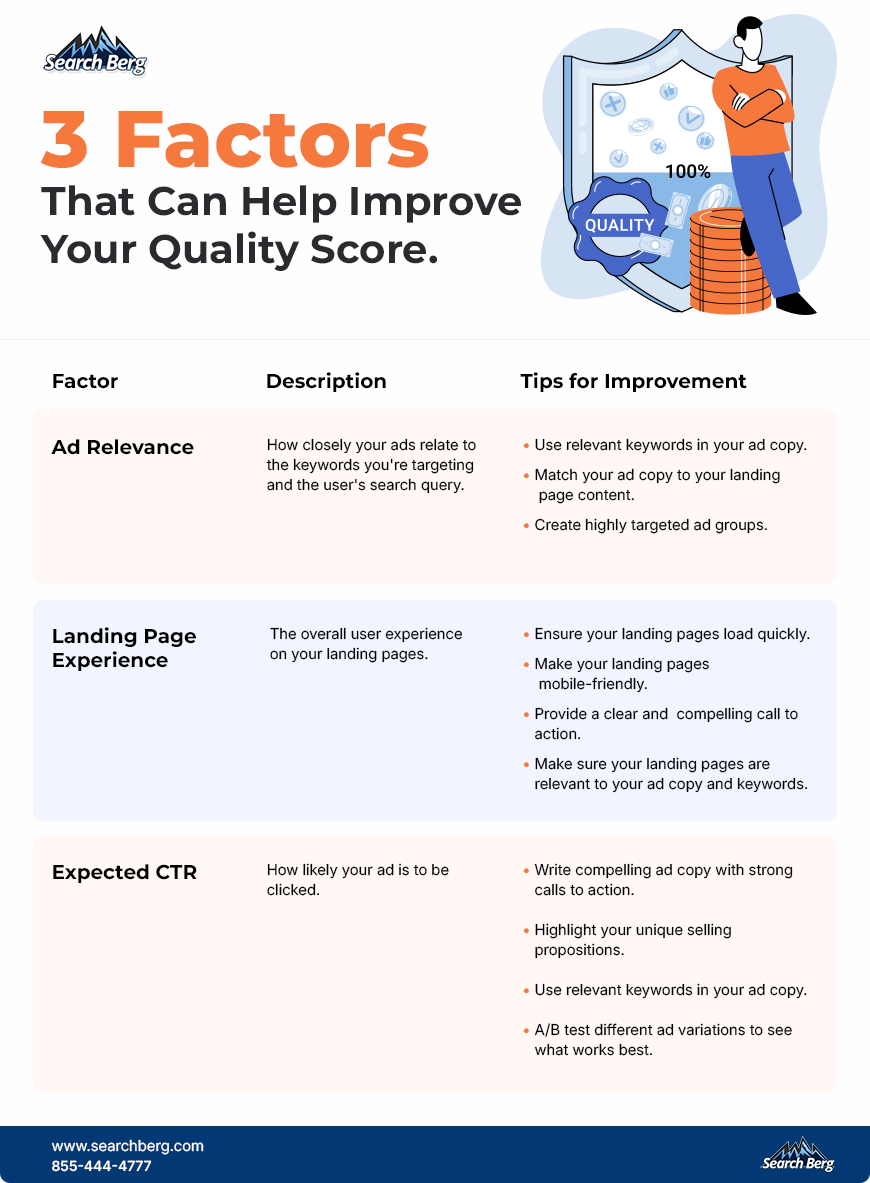
By consistently striving to improve these three elements, you can boost your Quality Score and make your campaign more effective and cost-efficient. This will help you lower your average cost per click and maximize your returns. The smart way.
Recommended Read: 5 Ways to Use Quality Score to Improve Your Performance
4.4. Target the Right Audience

Imagine you run a local bakery in San Francisco specializing in gluten-free pastries. Would you want to show your ads to everyone in the world? Probably not. You’d want to target your ads to people in San Francisco who are interested in gluten-free baked goods.
That’s the power of audience targeting in Google Ads.
By refining your targeting options, you can ensure that your ads are seen by the most qualified potential customers, i.e., the people who are most likely to be interested in your products or services and most likely to convert. This improves your click-through rates and conversion rates. It also helps you avoid wasting your budget on irrelevant impressions.
Google Ads offers a wide range of targeting options to help you reach the right audience:
- Demographic Targeting
This allows you to target your ads based on demographic characteristics like:
- Age
- Gender
- Household income
- Parental status
- Education level
- Marital status
For example, if you’re selling baby clothes, you may target your ads to parents with young children. Or, if you’re selling luxury watches, you might target your ads to individuals with high household incomes.
- Location Targeting
With location targeting, you can choose to show your ads to users in specific geographic locations like:
- Countries
- States
- Cities
- Zip codes
- Radius around a specific location
This is particularly useful for local businesses that want to target customers in their service area.
- Audience Targeting
This allows you to target your ads based on users’ interests, behaviors, and purchase intent. Google Ads offers several types of audience targeting, including:
- Affinity Audiences: These are broad groups of people who share common interests, e.g., sports fans, cooking enthusiasts, or travel buffs.
- In-Market Audiences: These are people who are actively researching or planning to purchase products or services in a specific category, e.g., cars, electronics, or travel.
- Remarketing: This allows you to target users who have previously interacted with your website or ads. For example, you could show ads to people who have visited your website but didn’t make a purchase.
- Customer Match: This allows you to upload your customer data (like email addresses) to Google Ads and create audiences based on that data. You can then target your ads to these specific customer segments.
- Similar Audiences: This allows you to reach new customers who share similar characteristics with your existing customer base. Google uses machine learning to identify these “lookalike” audiences.
For optimal results, use a combination of demographic targeting, location targeting, and audience targeting. Continuously test and refine your targeting options to see what works best for your business.
4.5. Conduct A/B Testing
A/B testing, also known as split testing, involves creating two or more versions of your ad with slight variations. These variations could be anything from different headlines and descriptions to contrasting calls to action or even distinct landing page experiences.
By running different versions simultaneously, you can gather valuable data on which elements perform best and use those insights to optimize your campaigns for maximum effectiveness.
Think of A/B testing as a scientific experiment for your ads. You’re essentially testing hypotheses about what will resonate most with your audience. Perhaps a more concise headline will grab attention more effectively, or maybe a stronger call to action will drive more conversions.
By systematically testing these variations, you can eliminate guesswork and make data-driven decisions that lead to improved campaign performance.
To conduct effective A/B tests, it’s important to focus on one element at a time. If you change too many variables at once, it will be difficult to determine which change had the greatest impact on your results.
Start by testing small variations, e.g., different headlines or calls to action. Once you’ve identified a winning variation, you can then move on to test other elements.
Remember, A/B testing is an ongoing process.
The digital arena is constantly shifting, and user preferences can change over time. Continuously test and refine your ads to ensure they remain relevant, engaging, and effective. By embracing a data-driven approach to optimization, you can unlock the full potential of your Google Ads campaigns and achieve remarkable results.
Recommended Read: A Comprehensive Guide to Google Ad Preview & Diagnosis Tool
4.6. Use Negative Keywords
You’ve crafted compelling ads, set your bids, and launched your Google Ads management campaigns. But are you reaching the right audience? Or are your ads being shown to users who are unlikely to convert, wasting your precious budget with every irrelevant click?
This is a common challenge in Google Ads, especially when using broad keywords that can trigger a wide range of searches. Fortunately, there’s a powerful tool at your disposal to address this issue: negative keywords.
Negative keywords are terms that you don’t want your ads to show up for. By adding them to your campaigns, you can prevent your ads from being triggered by irrelevant searches. This is an excellent way to save money and improve your overall campaign performance. It’s especially important when dealing with broad keywords that can have multiple interpretations.
Let’s illustrate this with an example.
Say you’re an online retailer selling high-quality leather handbags. You may be bidding on keywords like “leather bags” or “handbags.” However, these keywords could also trigger searches for “cheap leather bags,” “fake leather bags,” or even “leather dog bags.”
If your ads appear for these irrelevant searches, you’ll end up wasting your budget on clicks from users who aren’t interested in your products.
To prevent this, you would add negative keywords like “cheap,” “fake,” “discount,” “wholesale,” and “dog” to your campaign. This tells Google Ads not to show your ads for searches containing those terms, ensuring that your ads are only seen by users who are likely to be interested in your high-quality leather handbags.
Here are some tips for using negative keywords effectively:
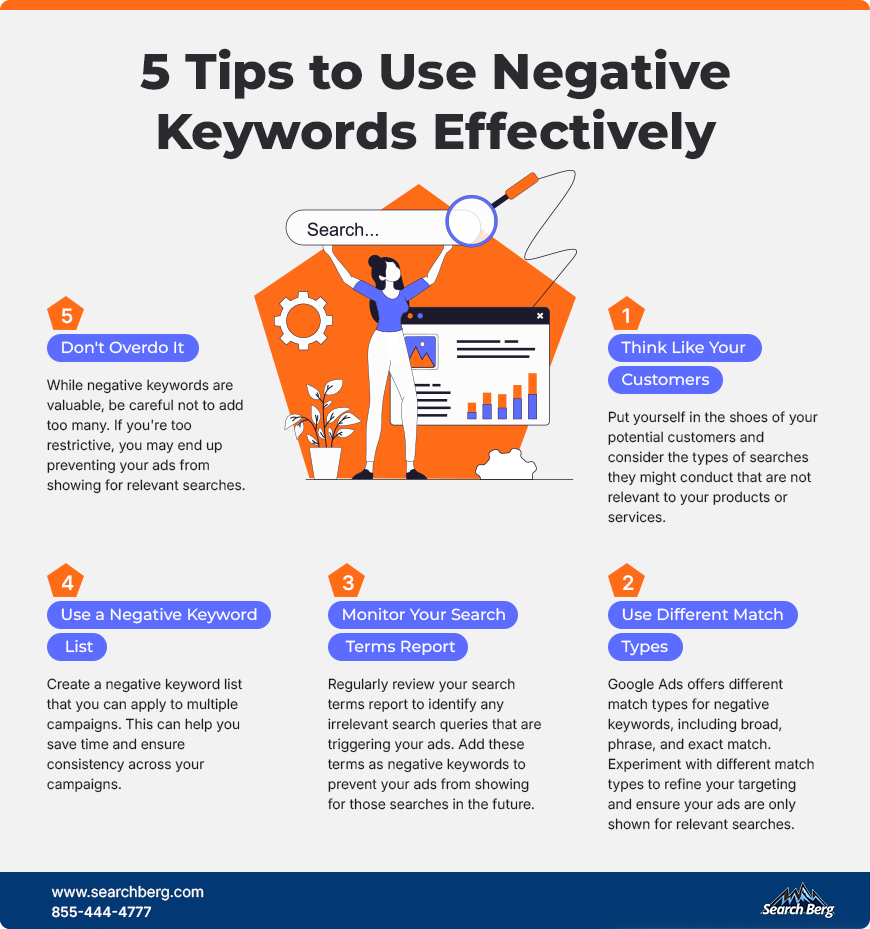
- Think Like Your Customers: Put yourself in the shoes of your potential customers and consider the types of searches they might conduct that are not relevant to your products or services.
- Use Different Match Types: Google Ads offers different match types for negative keywords, including broad, phrase, and exact match. Experiment with different match types to refine your targeting and ensure your ads are only shown for relevant searches.
- Monitor Your Search Terms Report: Regularly review your search terms report to identify any irrelevant search queries that are triggering your ads. Add these terms as negative keywords to prevent your ads from showing for those searches in the future.
- Use a Negative Keyword List: Create a negative keyword list that you can apply to multiple campaigns. This can help you save time and ensure consistency across your campaigns.
- Don’t Overdo It: While negative keywords are valuable, be careful not to add too many. If you’re too restrictive, you may end up preventing your ads from showing for relevant searches.
By strategically incorporating negative keywords into your Google Ads campaigns, you can refine your targeting, reduce wasted spend, and improve your overall campaign performance.
4.7. Leverage Google Ads Extensions
Your Google Ads are live, showcasing your products or services to the world. But are they reaching their full potential? Are you maximizing the impact of every ad, every click, and every dollar spent?
One often-overlooked strategy that can significantly enhance your Google Ads performance is the use of extensions. These powerful add-ons provide a way to enrich your ads with valuable information, making them more engaging, informative, and ultimately, more effective.
Think of extensions as a way to supercharge your ads. They allow you to showcase specific product pages, highlight promotions, display your business location, and even encourage users to call or download your app (all within the confines of your ad).
But the benefits of extensions go beyond just providing more information. They can also play a critical role in lowering your Google Ads cost and improving your overall campaign ROI. By increasing your click-through rates and enhancing your Quality Score, extensions can result in lower costs-per-click and better ad positions.
Let’s explore some of the most popular and effective Google Ads extensions:
- Sitelink Extensions: These allow you to add links to specific pages on your website, e.g., your “About Us” page, “Contact Us” page, or product pages. This gives users more options to explore your site and find what they’re looking for, increasing the likelihood of engagement and conversion.
- Location Extensions: If you have a physical store, location extensions are a must. They display your business address and a map to help users find your location easily. This is particularly useful for local businesses targeting customers in their service area.
- Call Extensions: Make it easy for potential customers to connect with you by adding a call extension to your ad. This allows users to call your business directly from your ad, streamlining the lead generation process.
- Promotion Extensions: Entice users with special offers and discounts by using promotion extensions. These eye-catching extensions can significantly increase click-through rates and drive conversions.
- Structured Snippet Extensions: Provide users with a glimpse into specific aspects of your products or services, e.g., brands, styles, types, or features. This helps users quickly assess whether your offerings align with their needs.
- Price Extensions: Showcase your products or services directly in your ads with price extensions. This allows users to see your pricing upfront, increasing transparency and attracting qualified clicks.
- App Extensions: If you have a mobile app, use app extensions to encourage users to download it. This can be a great way to drive app installs and increase user engagement.
Remember, the key to success with Google Ads extensions is relevance. Choose extensions that are relevant to your business, your products or services, and the keywords you’re targeting. Continuously monitor your campaign performance and experiment with different extensions to see what works best for you.
5. Frequently Asked Questions (FAQs)
1. What is a good ROI for Google Ads?
A “good” ROI for Google Ads varies depending on your industry, business goals, and profit margins. However, a common benchmark is a 2:1 ratio, i.e., you generate $2 in revenue for every $1 spent on Google Ads. Some businesses achieve even higher ROIs, while others may find a lower ratio acceptable depending on their specific circumstances.
2. What are the best Google Ads bidding strategies for beginners?
For beginners, automated bidding strategies like Maximize Clicks or Target CPA can be a good starting point. These strategies leverage Google’s machine learning to optimize your bids based on your campaign goals. As you gain more experience, you can explore manual bidding or more advanced automated strategies like Target ROAS.
3. How often should I monitor my Google Ads campaigns?
We recommend monitoring your Google Ads campaigns at least once a week, if not more frequently. This allows you to identify any performance issues, adjust your bidding strategies, and optimize your campaigns for better results. At Search Berg, our Google Ads management team does this for you.
4. What are some common Google Ads mistakes to avoid?
Some common mistakes include poor keyword research, neglecting landing page optimization, ignoring Quality Score, not tracking conversions, and overlooking mobile optimization. By avoiding these pitfalls, you can improve your campaign performance and maximize your ROI.
5. What is the difference between the Google Search Network and the Google Display Network?
The Google Search Network shows your ads on Google’s search results pages, while the Google Display Network shows your ads on websites across the internet. Search Network ads are typically more expensive but can be more effective for driving conversions. Display Network ads are generally more affordable and can be useful for building brand awareness.
6. What are some advanced Google Ads strategies I can use?
Once you’ve mastered the basics, explore advanced strategies like remarketing, dynamic keyword insertion, audience targeting, and geo-fencing to further optimize your campaigns and improve your ROI. If you partner with Search Berg, we’ll gradually incorporate these strategies into your Google Ads management plan.
6. Need Help with Your Google Ads?
You’ve invested time and effort in building your business. Now, it’s time to amplify your reach and drive growth with the power of Google Ads. But maximizing your return on investment requires a strategic approach and a deep understanding of the platform’s intricacies.
Search Berg is here to help.
Our team of experienced Google Ads experts will guide you every step of the way. Our job is to ensure your ads are seen by the right audience and consistently deliver exceptional results.
We offer a comprehensive suite of Google Ads management services, including:
- In-Depth Keyword Research: We find the most valuable keywords for your business, ensuring your ads reach the most qualified potential customers.
- Persuasive Ad Creation: Our expert copywriters craft compelling ad copy that captures attention and drives clicks.
- Strategic Campaign Management: We expertly optimize your bidding strategies, targeting options, and ad placements to maximize your ROI.
- Ongoing Performance Optimization:We continuously monitor and refine your campaigns to improve your Google Ads average cost-per-click and drive conversions.
- Transparent Reporting and Analysis: We provide you with clear and insightful reports, so you can track your progress and see the value of your investment.
Whether you’re a small business looking to get started with Google Ads or a large enterprise seeking advanced campaign management and optimization, Search Berg has the expertise and experience to help you succeed.
Contact us today for a free consultation.
[blog_form6]
Ready to Master Google Ads and Achieve a Sky-High ROI?
Claim your free Google Ads management consultation today and let’s give your business the PPC punch it needs to accelerate and dominate. We’re ready when you are!
No spam, just expert advice!


